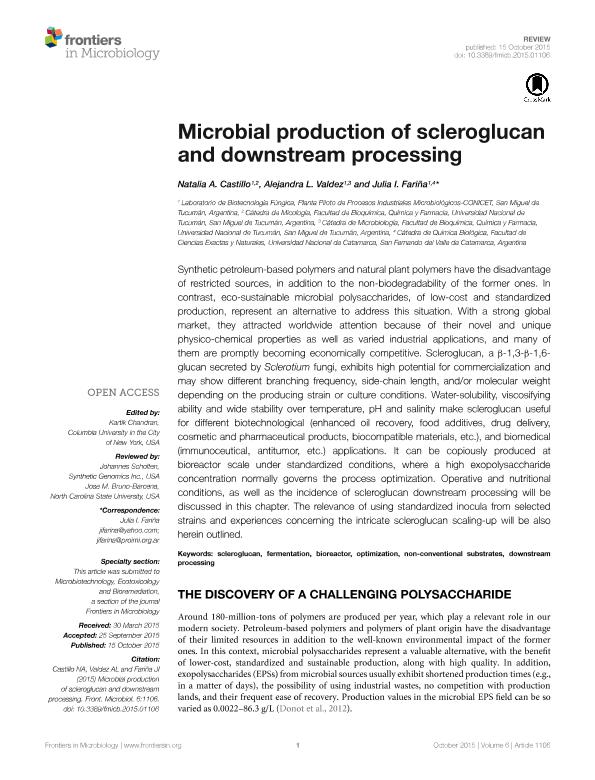Mostrar el registro sencillo del ítem
dc.contributor.author
Castillo, Natalia Alejandra

dc.contributor.author
Valdez, Alejandra Leonor

dc.contributor.author
Fariña, Julia Inés

dc.date.available
2017-05-23T15:29:24Z
dc.date.issued
2015-10-15
dc.identifier.citation
Castillo, Natalia Alejandra; Valdez, Alejandra Leonor; Fariña, Julia Inés; Microbial production of scleroglucan and downstream processing; Frontiers; Frontiers in microbiology; 6; 1106; 15-10-2015; 1-19
dc.identifier.issn
1664-302X
dc.identifier.uri
http://hdl.handle.net/11336/16860
dc.description.abstract
Synthetic petroleum-based polymers and natural plant polymers have the disadvantage of restricted sources, in addition to the non-Biodegradability of the former ones. In contrast, eco-sustainable microbial polysaccharides, of low-cost and standardized production, represent an alternative to address this situation. With a strong globalmarket, they attracted worldwide attention because of their novel and unique physico-chemical properties as well as varied industrial applications, and many of them are promptly becoming economically competitive. Scleroglucan, a β-1,3-β-1,6- glucan secreted by Sclerotium fungi, exhibits high potential for commercialization and may show different branching frequency, side-chain length, and/or molecular weightdepending on the producing strain or culture conditions. Water-solubility, viscosifying ability and wide stability over temperature, pH and salinity make scleroglucan useful for different biotechnological (enhanced oil recovery, food additives, drug delivery,cosmetic and pharmaceutical products, biocompatible materials, etc.), and biomedical(immunoceutical, antitumor, etc.) applications. It can be copiously produced at bioreactor scale under standardized conditions, where a high exopolysaccharide concentration normally governs the process optimization. Operative and nutritional conditions, as well as the incidence of scleroglucan downstream processing will be discussed in this chapter. The relevance of using standardized inocula from selectedstrains and experiences concerning the intricate scleroglucan scaling-up will be also herein outlined.
dc.format
application/pdf
dc.language.iso
eng
dc.publisher
Frontiers

dc.rights
info:eu-repo/semantics/openAccess
dc.rights.uri
https://creativecommons.org/licenses/by/2.5/ar/
dc.subject
Polysaccharides
dc.subject
Microbial Eps
dc.subject
Fermentation
dc.subject
Applications
dc.subject
Bioreactor
dc.subject
Non-Conventional Substrates
dc.subject.classification
Bioproductos, Biomateriales, Bioplásticos, Biocombustibles, Bioderivados, etc.

dc.subject.classification
Biotecnología Industrial

dc.subject.classification
INGENIERÍAS Y TECNOLOGÍAS

dc.title
Microbial production of scleroglucan and downstream processing
dc.type
info:eu-repo/semantics/article
dc.type
info:ar-repo/semantics/artículo
dc.type
info:eu-repo/semantics/publishedVersion
dc.date.updated
2016-02-05T15:00:31Z
dc.journal.volume
6
dc.journal.number
1106
dc.journal.pagination
1-19
dc.journal.pais
Suiza

dc.journal.ciudad
Lausanne
dc.description.fil
Fil: Castillo, Natalia Alejandra. Consejo Nacional de Investigaciones Científicas y Técnicas. Centro Científico Tecnológico Tucumán. Planta Piloto de Procesos Industriales Microbiológicos (i); Argentina. Universidad Nacional de Tucumán; Argentina
dc.description.fil
Fil: Valdez, Alejandra Leonor. Consejo Nacional de Investigaciones Científicas y Técnicas. Centro Científico Tecnológico Tucumán. Planta Piloto de Procesos Industriales Microbiológicos (i); Argentina. Universidad Nacional de Tucumán; Argentina
dc.description.fil
Fil: Fariña, Julia Inés. Consejo Nacional de Investigaciones Científicas y Técnicas. Centro Científico Tecnológico Tucumán. Planta Piloto de Procesos Industriales Microbiológicos (i); Argentina. Universidad Nacional de Catamarca; Argentina
dc.journal.title
Frontiers in microbiology
dc.relation.alternativeid
info:eu-repo/semantics/altIdentifier/url/http://journal.frontiersin.org/article/10.3389/fmicb.2015.01106/abstract
dc.relation.alternativeid
info:eu-repo/semantics/altIdentifier/doi/http://dx.doi.org/10.3389/fmicb.2015.01106
Archivos asociados
